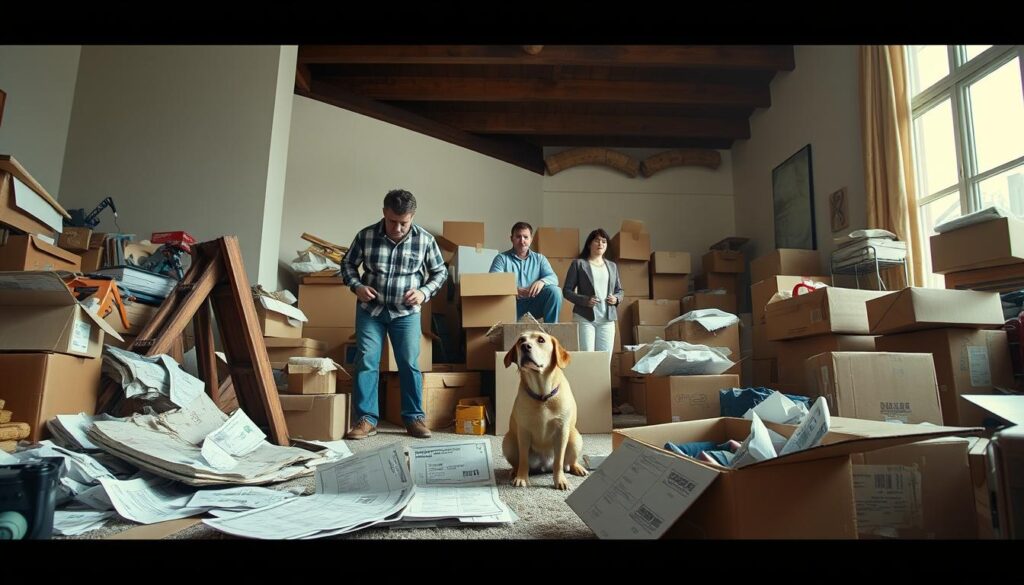What is the most expensive part of moving?
Get Your Free Moving Estimate
When it comes to relocation, one pressing question often surfaces: what is the most expensive part of moving? Navigating the landscape of expensive moving expenses can be overwhelming, but understanding the costliest part of moving is crucial for effective planning. From transporting your belongings to settling in, each element contributes to high moving costs. In this section, we’ll delve into the various dimensions of moving expenses, providing insights that can help urban homeowners and businesses budget effectively for a seamless transition.
Key Takeaways
- The most significant costs in moving often stem from transportation.
- Planning and preparation can help mitigate unexpected high moving costs.
- Understanding your specific needs can help identify the costliest part of moving.
- Hidden expenses can arise if not properly budgeted for.
- Professional assistance may be worth the investment to streamline the process.
Understanding the Costs Involved in Moving
Comprehending the various costs associated with moving serves as a cornerstone for effective budgeting for moving. This guide aims to break down the major expenses that may arise during the moving process. Being aware of these moving costs can help prevent unwelcome financial surprises, allowing for smoother transitions.
Overview of Moving Expenses
The moving process encompasses a range of expenses, including:
- Transportation Costs: This expense covers the logistics of getting your belongings from one location to another, often accounting for a significant portion of the overall moving costs.
- Labor Costs: If you opt for costly moving services, this includes the fees for hiring professionals to assist with the heavy lifting and logistics. For those considering a DIY approach, this reflects the time and effort needed to manage the move independently.
- Packing Supplies: Essential for safeguarding your items, these supplies can add to the financial burden, especially if not planned for in advance.
Hidden Costs to Anticipate
When budgeting for moving, be vigilant about hidden costs that could catch many off guard. These may include:
- Costs related to cancellations or delays in service.
- Unexpected fees for added services such as weekend moves or accessorial charges.
- Deposits or utility connection fees at the new location.
The Largest Expense: Transportation Costs
Understanding transportation costs is essential for effective moving budget planning. This aspect generally constitutes the largest expense during a move. Several factors influence these costs, making it crucial to evaluate them before finalizing your moving strategy.
Factors Affecting Transportation Costs
- Distance of the Move: Longer distances typically result in higher fees.
- Volume of Items: The greater the number of items, the more costly the transportation will be.
- Time of Year: Moving during peak seasons can lead to increased rates.
Comparing DIY vs. Professional Movers
When deciding between a DIY approach and hiring professional movers, consider the following:
| Aspect | DIY Moving | Professional Moving |
|---|---|---|
| Transportation Costs | Potentially lower, but includes gas and rental fees | Higher upfront costs, includes labor and transportation |
| Time and Effort | Time-consuming, requires personal effort | Faster, handled by experienced movers |
| Risk of Damage | Higher risk without professional handling | Lower risk with trained professionals |
Evaluating these elements assists in comprehensively understanding expensive moving expenses, allowing for effective decision-making during moving budget planning.
Packing Supplies: An Overlooked Expense
Packing supplies play a crucial role in the moving process, often contributing significantly to the price of moving supplies. Many underestimate these costs, leading to unexpected high moving costs that could impact their overall budget. Understanding the types of packing materials available can help in making informed decisions, while knowing where to save can assist in cost management.
Types of Packing Materials
Various packing materials are essential for a successful move. Key items include:
- Boxes of different sizes
- Bubble wrap for fragile items
- Packing tape for secure sealing
- Markers for labeling
- Specialty items, like wardrobe boxes and foam peanuts
Where to Save on Packing Supplies
Finding ways to cut costs on packing supplies can significantly reduce your moving expenses. Consider these options:
- Repurpose boxes from local retailers
- Use old blankets or towels for cushioning
- Purchase packing materials in bulk
- Look for discounts or sales at moving supply stores
By being strategic about packing supplies, we can mitigate high moving costs and ensure a more budget-friendly moving experience.
| Item | Approximate Price | Tip for Saving |
|---|---|---|
| Standard Moving Box | $2 – $5 each | Get used boxes from grocery stores or friends |
| Bubble Wrap | $15 – $25 per roll | Use alternative cushioning like clothes |
| Packing Tape | $3 – $10 per roll | Buy in bulk or during sales |
| Wardrobe Box | $10 – $20 each | Rent from moving companies instead of buying |
Labor Costs: Hiring Professional Help
When planning a move, labor costs play a significant role in determining the overall budget. Hiring professional movers can mitigate the burden associated with managing the logistics, ensuring a smoother transition while addressing high moving costs effectively. Utilizing experienced move teams not only alleviates stress but also can be a cost-effective strategy in the long run.
The Benefits of Professional Movers
Engaging professional movers presents various advantages that contribute to a successful moving experience. Here are some key benefits:
- Expertise and Experience: Professional movers possess knowledge of best practices in transporting delicate items.
- Time-Saving: Their efficiency in packing and transferring goods accelerates the moving process.
- Safety: With proper handling techniques, the risks of damage to property are minimized.
- Equipment: Access to specialized tools helps streamline the moving process.
Average Labor Costs by Region
Understanding labor costs across different regions can help in budgeting for one of the more expensive moving expenses. Below is a breakdown of average labor costs based on geographic areas:
| Region | Average Labor Cost (per hour) |
|---|---|
| Northwest | $90 |
| Midwest | $80 |
| Southeast | $75 |
| Northeast | $100 |
| Southwest | $85 |
Storage Fees: A Variable Expense
When planning a move, considering storage fees can significantly impact your overall budgeting for moving. Unforeseen circumstances may arise, necessitating the need for temporary or long-term storage solutions. Understanding when and why to utilize storage is crucial in managing expensive moving expenses.
When to Consider Storage Solutions
There are various situations that might prompt the use of a storage unit during your moving process:
- Timing Constraints: If there is a gap between moving out of your old home and into your new one.
- Home Renovations: When your new space requires improvements before you can move in.
- Downsizing: If you’re moving into a smaller space and need to store extra belongings.
Price Range for Storage Units
In Austin, Texas, the cost of storage units can vary widely depending on the size and features. Below is a table illustrating average monthly prices for different types of storage units:
| Storage Unit Size | Average Monthly Cost | Typical Features |
|---|---|---|
| 5×5 ft | $50 – $100 | Small items, less than 25 boxes |
| 10×10 ft | $100 – $150 | Apt. furnishings, appliances |
| 10×20 ft | $150 – $250 | Household items, larger vehicles |
Incorporating storage costs into your budgeting for moving allows for a smoother transition without unexpected financial strains. Being aware of potential storage fees can help ensure you remain on track with your financial planning.
Insurance Costs: Protecting Your Belongings
In the moving process, insurance costs play a crucial role in safeguarding your valuable possessions. Understanding this aspect helps prevent unexpected financial burdens during a transition. Our focus here is on different types of moving insurance and appraising your specific needs.
Types of Moving Insurance
The nature of insurance varies significantly and can impact your moving budget planning. Here are the main types of moving insurance options available:
- Basic Liability Coverage: This is often included in the cost of moving services. It covers a limited amount per pound of damaged goods.
- Full-Value Protection: This provides more comprehensive coverage where the mover must repair, replace, or compensate for lost or damaged items in their entirety.
- Third-Party Insurance: Available for specific items or high-value belongings, this option may require additional fees from other providers.
Assessing Your Insurance Needs
Each move presents unique challenges, making it critical to evaluate your insurance needs adequately. Consider the following factors:
- The total value of your belongings: Higher values often necessitate greater coverage.
- The distance of your move: Long-distance relocations may warrant more coverage due to the increased risk.
- Your comfort level with risk: Understanding what items you are willing to insure fully versus those you can afford to lose helps in deciding the level of coverage.

Utility Setup and Change Fees
Moving into a new home involves more than just packing and unloading boxes. One significant aspect often overlooked is the setup of utilities. Understanding utility fees associated with transferring services can help prevent unexpected financial strain.
Costs of Transferring Utilities
Transferring utilities typically incurs various fees charged by service providers. Utility companies often levy costs for switching services from one address to another. The specific fees vary based on the provider and the types of services required. Here is a brief overview of potential costs:
- Connection fees for electricity and gas
- Water service transfer fees
- Internet and cable activation costs
Possible Deposits and Service Charges
In addition to the transfer fees, new utility accounts may require security deposits. This is a common hidden cost to anticipate when budgeting for a move. The amount can depend on your credit score, past payment history, or specific utility provider policies. Keep an eye out for:
- One-time deposit requirements
- Monthly service charges that could add up
- Potential late fees if payments are delayed
This insight is particularly important for those planning additional costs for long-distance moves, as utility setup can vary considerably between states. Understanding these fees allows for smoother transitions and better financial planning.
| Utility Type | Typical Transfer Fee | Possible Deposit |
|---|---|---|
| Electricity | $50 – $100 | $100 – $200 |
| Gas | $30 – $70 | $50 – $150 |
| Water | $25 – $50 | $50 – $100 |
| Internet | $50 – $150 | $0 – $100 |
Travel Expenses: Moving Across Long Distances
Long-distance moving often brings hidden travel expenses that can significantly impact your budget. These costs accumulate as you factor in various aspects of your journey. Understanding these expenses helps in planning a more efficient move.
Costs of Fuel and Hotels
When calculating travel expenses for a long-distance move, fuel consumption plays a crucial role. The distance you travel directly affects the amount you’ll spend on gas. Additionally, if the journey requires more than one day, hotel accommodations become necessary. Here’s a breakdown of potential costs:
| Distance (miles) | Estimated Fuel Cost | Estimated Hotel Cost |
|---|---|---|
| 500 | $100 | $150 |
| 1000 | $200 | $300 |
| 1500 | $300 | $400 |
Additional Costs for Long-Distance Moves
In addition to the main travel expenses, several other factors contribute to expensive moving expenses. These might include:
- Meals during travel: Food costs can add up, especially on longer journeys.
- Vehicle maintenance: Ensure your vehicle is in good condition before setting off to avoid unexpected breakdowns.
- Pet care arrangements: If traveling with pets, consider boarding or travel supplies.
Being aware of all potential expenses enables better financial planning and reduces stress during the move. Reviewing these details ensures you’re prepared for the various challenges of long-distance moving.
Unforeseen Expenses: Planning for the Unexpected
Even with careful moving budget planning, unforeseen expenses can derail even the best-laid plans. Timing and circumstances often contribute to unexpected costs that arise during the moving process. Understanding these potential pitfalls allows us to prepare effectively.
Common Unexpected Costs in Moving
- Purchasing additional packing supplies when initial estimates fall short.
- Making last-minute changes to your mover, which can incur higher fees.
- Unforeseen repairs or cleanup needed for a new home before moving in.
Tips to Mitigate Surprise Expenses
- Establish a contingency fund specifically for unforeseen expenses.
- Work with reliable and transparent moving services like HeavenlyMove to minimize surprises.
- Regularly review and adjust your moving budget planning to account for any new developments.

Budgeting for Your Move: A Step-by-Step Guide
Having covered the various costs associated with moving, it’s time to focus on budgeting for moving effectively. Creating a realistic moving budget involves understanding the expenses you’ve gathered and organizing them in a way that allows for necessary flexibility. Begin by listing all anticipated costs, from transportation and labor to packing supplies and utility changes. This comprehensive approach ensures you won’t overlook any crucial expenses and prepares you for a smoother relocation process.
Creating a Realistic Moving Budget
In our experience, a successful moving budget planning strategy incorporates both fixed and variable expenses. Start by estimating each cost, factoring in potential unforeseen expenses as a cushion in your budget. By being honest about what you can afford, you set yourself up for success. Remember, it’s essential to revisit and adjust your budget as needed throughout the moving process to reflect actual expenses accurately.
Tools and Resources for Budgeting
To simplify your moving budget planning, consider utilizing various tools for budgeting. There are numerous apps designed to help you track expenses and manage your financial plan effectively—choose one that aligns with your preferences and lifestyle. Spreadsheets can also serve as a practical option for organizing your costs. By leveraging these resources, you can maintain control over your budget and ensure your move stays within financial limits.


